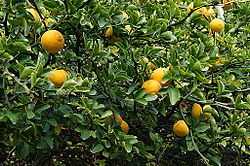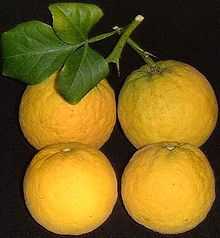Trifoliate orange
| Trifoliate orange Poncirus trifoliata | |
|---|---|
 | |
| Scientific classification | |
| Kingdom: | Plantae |
| (unranked): | Angiosperms |
| (unranked): | Eudicots |
| (unranked): | Rosids |
| Order: | Sapindales |
| Family: | Rutaceae |
| Subfamily: | Aurantioideae |
| Tribe: | Citreae |
| Genus: | Poncirus (disputed) Raf. |
| Species: | P. trifoliata |
| Binomial name | |
| Poncirus trifoliata (L.) Raf. | |
| Synonyms | |
|
Citrus trifoliata (L.) | |
Trifoliate orange, Poncirus trifoliata (syn. Citrus trifoliata), is a member of the family Rutaceae, closely related to Citrus, and sometimes included in that genus, being sufficiently closely related to allow it to be used as a rootstock for Citrus. It differs from Citrus in having deciduous, compound leaves, and pubescent (downy) fruit.
It is native to northern China and Korea, and is also known as the Chinese Bitter Orange or Hardy Orange.[1]
The plant is a fairly cold hardy citrus (USDA zone 5) and will tolerate moderate frost and snow, making a large shrub or small tree 4–8 m tall. Because of the relative hardiness of Poncirus, citrus grafted onto it are usually hardier than when grown on their own roots.
Description
Poncirus trifoliata is recognisable by the large 3–5 cm thorns on the shoots, and its deciduous leaves with three (or rarely, five) leaflets, typically with the middle leaflet 3–5 cm long, and the two side leaflets 2–3 cm long. The flowers are white, with pink stamens, 3–5 cm in diameter, larger than those of true citrus but otherwise closely resembling them, except that the scent is much less pronounced than with true citrus. As with true citrus, the leaves give off a spicy smell when crushed.
The fruits are green, ripening to yellow, and 3–4 cm in diameter, resembling a small orange, but with a finely downy surface. They are very bitter, are not edible fresh, but can be made into marmalade, and when dried and powdered, they can be used as a condiment.

Uses
Cultivation
The cultivar "Flying Dragon" is dwarfed in size and has highly twisted, contorted stems. It makes an excellent barrier hedge due to its density and strong curved thorns. Such a hedge had been grown for over 50 years at Oklahoma State University in Stillwater.[1]
Medicine
Traditional medicine
The fruits of Poncirus trifoliata are widely used in Oriental medicine as a remedy for allergic inflammation.[2]
Potential pharmacology

In vitro studies show that extracts of the fruits of Poncirus trifoliata inhibit NF-κB activation in mast cells.[3] The chemical compounds neohesperidin and poncirin isolated from Poncirus trifoliata may be useful for the treatment of, and protection from, gastritis.[4] Poncirus trifoliata extracts have been shown to possess in vitro anti-allergic, antitumor,[5][6] anti-inflammatory and antiviral activities.[7] Poncirus trifoliata extract could possess a wide range of beneficial activities for neurodegenerative disorders.[8] A water extract, taken for 10 weeks, suppressed weight gain in rats.[9]
See also
- Citrange
- Citrus taxonomy
- Cold hardy citrus
Gallery
-

Flower
-

Flowers
-

Fruits
-

Green fruits
References
- ↑ 1.0 1.1 Gerald Klingaman. "Plant of the Week. Hardy Orange or Trifoliate Orange. Latin: Poncirus trifoliat". University of Arkansas. Division of Agriculture.
- ↑ Zhou H.Y., Shin E.M., Guo L.Y., Zou L.B., Xu G.H., Lee S.-H., Ze K.R., Kim E.-K., Kang S.S., Kim Y.S.,"Anti-inflammatory activity of 21(alpha, beta)-methylmelianodiols, novel compounds from Poncirus trifoliata Rafinesque." European Journal of Pharmacology. 572 (2-3) (pp 239-248), 2007.
- ↑ Shin T.-Y., Oh J.M., Choi B.-J., Park W.-H., Kim C.-H., Jun C.-D., Kim S.-H.,"Anti-inflammatory effect of Poncirus trifoliata fruit through inhibition of NF-B activation in mast cells". Toxicology in Vitro. 20 (7) (pp 1071-1076), 2006.
- ↑ Lee JH, Lee SH, Kim YS, Jeong CS "Protective effects of neohesperidin and poncirin isolated from the fruits of Poncirus trifoliata on potential gastric disease". Phytother Res. 2009 Apr 15;
- ↑ Yi J.-M., Kim M.-S., Koo H.-N., Song B.-K., Yoo Y.-H., Kim H.-M.,"Poncirus trifoliata fruit induces apoptosis in human promyelocytic leukemia cells." Clinica Chimica Acta. 340 (1-2) (pp 179-185), 2004
- ↑ Chung H.-J., Park E.-J., Pyee Y., Hua Xu G., Lee S.-H., Kim Y.S., Lee S.K."25-Methoxyhispidol A, a novel triterpenoid of Poncirus trifoliata, inhibits cell growth via the modulation of EGFR/c-Src signaling pathway in MDA-MB-231 human breast cancer cells." Food and Chemical Toxicology. 49 (11) (pp 2942-2946), 2011.
- ↑ Hong J, Min HY, Xu GH, Lee JG, Lee SH, Kim YS, Kang SS, Lee SK.,"Growth inhibition and G1 cell cycle arrest mediated by 25-methoxyhispidol A, a novel triterpenoid, isolated from the fruit of Poncirus trifoliata in human hepatocellular carcinoma cells." Planta Med. 2008 Feb;74(2):151-5
- ↑ Kim J.K., Bae H., Kim M.-J., Choi S.J., Cho H.Y., Hwang H.-J., Kim Y.J., Lim S.T., Kim E.K., Kim H.K., Kim B.Y., Shin D.-H."Inhibitory effect of poncirus trifoliata on acetylcholinesterase and attenuating activity against trimethyltin-induced learning and memory impairment." Bioscience, Biotechnology and Biochemistry. 73 (5) (pp 1105-1112), 2009
- ↑ Shim W.-S., Back H., Seo E.-K., Lee H.-T., Shim C.-K., "Long-term administration of an aqueous extract of dried, immature fruit of Poncirus trifoliata (L.) Raf. suppresses body weight gain in rats". Journal of Ethnopharmacology. 126 (2) (pp 294-299), 2009
| Wikimedia Commons has media related to Poncirus trifoliata. |
